Related Research Articles

A visa is a conditional authorization granted by a territory to a foreigner, allowing them to enter, remain within, or to leave that territory. Visas typically may include limits on the duration of the foreigner's stay, areas within the country they may enter, the dates they may enter, the number of permitted visits or an individual's right to work in the country in question. Visas are associated with the request for permission to enter a territory and thus are, in most countries, distinct from actual formal permission for an alien to enter and remain in the country. In each instance, a visa is subject to entry permission by an immigration official at the time of actual entry, and can be revoked at any time. Visa evidence most commonly takes the form of a sticker endorsed in the applicant's passport or other travel document but may also exist electronically. Some countries no longer issue physical visa evidence, instead recording details only in immigration databases.

Tokyo Station is a railway station in Chiyoda, Tokyo, Japan. The original station is located in Chiyoda's Marunouchi business district near the Imperial Palace grounds. The newer Eastern extension is not far from the Ginza commercial district. Due to the large area covered by the station, it is divided into the Marunouchi (west) and Yaesu (east) sides in its directional signage.
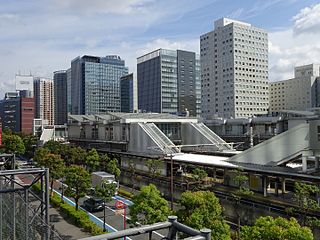
Ōsaki Station is a railway station in Shinagawa, Tokyo, Japan, jointly operated by East Japan Railway Company and Tokyo Waterfront Area Rapid Transit (TWR).
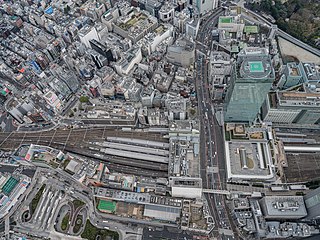
Shinjuku Station is a major railway station in the Shinjuku and Shibuya wards in Tokyo, Japan. In Shinjuku, it is part of the Nishi-Shinjuku and Shinjuku districts. In Shibuya, it is located in the Yoyogi and Sendagaya districts. It is the world's busiest railway station.

Ikebukuro Station is a major railway station located in the Ikebukuro district of Toshima, Tokyo, Japan, shared by the East Japan Railway Company, Tokyo subway operator Tokyo Metro, and the two private railway operators Seibu Railway and Tobu Railway. With 2.71 million passengers on an average daily in 2007, it is the second-busiest railway station in the world, and the busiest station in the Tobu, Seibu, and Tokyo Metro networks. It primarily serves commuters from Saitama Prefecture and other residential areas northwest of the city centre. It is the Tokyo terminal of the Seibu Ikebukuro Line and the Tobu Tojo Line.

Shibuya Station is a railway station in Shibuya, Tokyo, Japan, operated jointly by East Japan Railway Company, Keio Corporation, Tokyu Corporation, and Tokyo Metro. With 2.4 million passengers on an average weekday in 2004, it is the fourth-busiest commuter rail station in Japan and the world handling a large amount of commuter traffic between the center city and suburbs to the south and west.
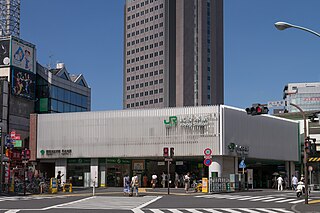
Yoyogi Station is a railway station in Shibuya, Tokyo, Japan, operated by the East Japan Railway Company and the Tokyo Metropolitan Bureau of Transportation (Toei). It is station E-26 under Toei's numbering system.

Okachimachi Station is a railway station in Taito, Tokyo, Japan, operated by East Japan Railway Company.

Kanda Station is a railway station in Chiyoda, Tokyo, Japan. East Japan Railway Company and Tokyo Metro operate individual portions of the station.

Ochanomizu Station is a railway station in Tokyo, Japan, operated by the East Japan Railway Company and Tokyo subway operator Tokyo Metro.

Sendai Station is a major junction railway station in Aoba-ku, Sendai, Miyagi, Japan. It is a stop for all Akita and Tohoku Shinkansen trains, the eastern terminus for the Senzan Line, and major stop on both the Tohoku Main Line and Senseki Line. It is located on the border between Miyagino and Aoba Wards in Sendai, Miyagi Prefecture.
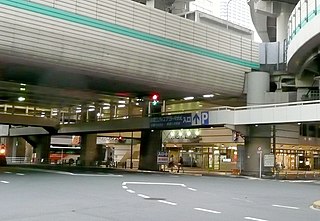
Tokyo City Air Terminal, also known as T-CAT, is a bus terminal for Airport Transport Service, an airport bus operator, in downtown Tokyo, Japan. The terminal is located in Nihonbashi-Hakozaki-cho, Chuo-ku, beneath Hakozaki Junction, the three-way interchange for Shuto Expressway's Mukojima Route and Fukagawa Route, three blocks southeast of Suitengu shrine. T-CAT is a gateway for passengers going to and from Narita International Airport and Tokyo International Airport (Haneda).

Motomachi-Chukagai Station is an underground railway station on the Minatomirai Line subway in Naka-ku, Yokohama, Kanagawa Prefecture, Japan, operated by the third-sector railway operating company Yokohama Minatomirai Railway Company. It is numbered "MM06", and its official name, as shown on signage in the station, is "Motomachi-Chūkagai Station (Yamashita-kōen)" with the sub-name in parentheses, although the use of this full name is limited.

Okayama Station is a railway station in Kita-ku, Okayama, Okayama Prefecture, Japan. The station is operated by West Japan Railway Company.

Ichon Station is a station in Yongsan-gu, Seoul on Seoul Subway Line 4 and Gyeongui–Jungang Line. This station is the closest to the National Museum of Korea, situated in the interior of Yongsan Family Park. It also serves eastern Ichon-dong, home to the largest Japanese community in South Korea with some 1,300 Japanese residents.

Kita-Kamakura Station is a railway station on the Yokosuka Line in Kamakura, Kanagawa, Japan, operated by East Japan Railway Company.

Sakae Station is an underground metro station located in Naka-ku, Nagoya, Aichi Prefecture, Japan operated by the Nagoya Municipal Subway. It is an interchange station between the Higashiyama Line and the Meijō Line and is located 9.0 rail kilometers from the terminus of the Higashiyama Line at Takabata Station and 3.0 rail kilometers from the terminus of the Meijō Line at Kanayama Station. This station is located in part of the upper class district of Nagoya.
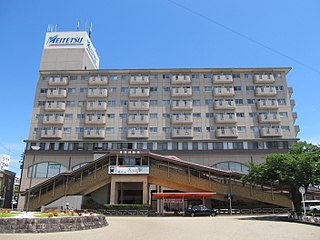
Inuyama Station is a railway station in the city of Inuyama, Aichi Prefecture, Japan, operated by Meitetsu.

Visa requirements for United States citizens and non-citizen nationals are administrative entry restrictions by the authorities of other states placed on citizens of the United States.
Exit Tunes, Inc. (エグジットチューンズ株式会社) is a Japanese media company that acts primarily as a music publisher. The company was founded as a printing company in 2001, however later became a music company known as Quake Records in 2003. In 2005, the company was renamed to Quake Holdings. The company became a subsidiary of Pony Canyon in 2009, and was renamed Exit Tunes in 2011.